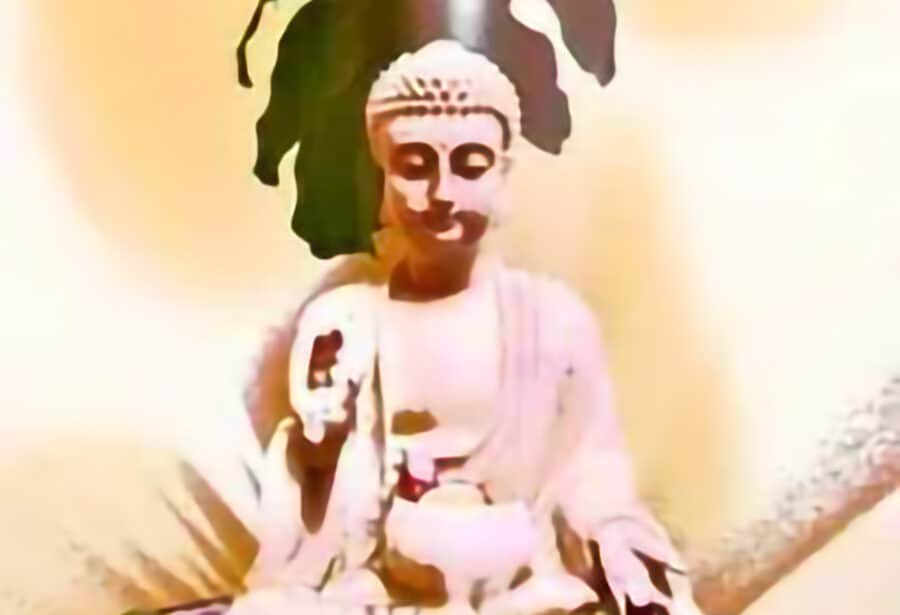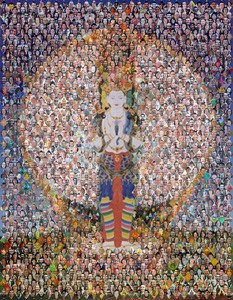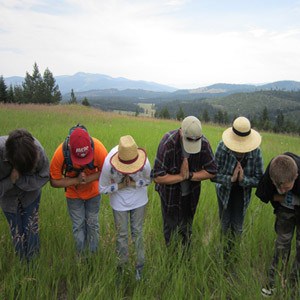The preliminary practice of taking refuge
The preliminary practice of taking refuge

Instructions on the ngondro practice of taking refuge. Visualizing the refuge objects and taking refuge. From the Jor Cho Puja.
Before me amidst an ocean of Samantabhadra offerings, in the middle of a spacious throne of precious gems, is a (smaller) radiant, jeweled throne. On cushions of variegated lotus, sun and moon is my root spiritual mentor in the aspect of Shakyamuni Buddha. His body is of pure gold radiant light and is adorned with a crown protrusion. The Buddha’s left hand is in the gesture of meditation and his right hand in the earth-touching gesture. He sits in the vajra cross-legged position, wearing the three brilliant saffron robes. Rays brighter than the sun radiate from his body in the ten directions. Eyes never tire of his resplendent form with its perfect, vivid signs and marks. Ears never tire of his enchanting speech with its sixty melodies. His vast and profound mind is a treasure of knowledge and love whose depth is beyond measure. Free from all stains of imperfection, he is the consummation of all good qualities. The mere recollection of the Buddha dispels the anxieties of cyclic existence and self-complacent peace. He displays manifold amazing powers, like the twelve deeds, to tame beings in countless worlds.
In the space to his right sits Maitreya surrounded by the spiritual mentors of the lineage of extensive deeds. In the space to his left sit Manjushri and the spiritual mentors of the lineage of the profound view. In front of Buddha Shakyamuni is my own root spiritual mentor in the aspect of giving teachings, surrounded by the spiritual mentors with whom I have a Dharma connection, seated upon cushions of lotus, sun and moon.
In the space behind Buddha Shakyamuni, sits Vajradhara, victorious lord of myriad tantras, surrounded by the lineage of spiritual mentors of the blessing of the practice. In the four directions around Buddha Shakyamuni and his retinue sit Guhyasamaja, Chakrasamvara, Vajrabhairava and Kalachakra with their mandalas. Beyond these are the meditational deities, Buddhas, bodhisattvas, hearer arhats and solitary-realizer arhats, dakas, dakinis, Dharma protectors, and the four directional protectors in innumerable peaceful and forceful aspects on their respective seats.
On either side of the lineage spiritual mentors who conferred empowerment, teachings and instructions of the vinaya, sutra, abhidharma, and tantra, are splendid stands with their teachings of the holy Dharma, represented by brilliantly radiant texts. Thus all space is filled with objects of refuge.
Surrounding me are gathered all beings of the six realms, overwhelmed by the various difficulties and sufferings of samsara. In the face of such constantly recurring problems, we seek the protection and guidance of the spiritual mentors and the Three Jewels.
The passage above describes the extensive visualization. A simpler way is to visualize Shakyamuni Buddha in the center, surrounded by all the spiritual mentors, deities, Buddhas (1000 Buddhas of the fortunate eon, seven Medicine Buddhas, 35 confession Buddhas, etc.), bodhisattva, arhats, dakas and dakinis, and protectors. An even more condensed visualization is simply to imagine Shakyamuni Buddha. See the Buddha as the embodiment of all the spiritual mentors, all the Buddhas, all the Dharma, all the Sangha. Or think Shakyamuni Buddha’s body is the Sangha, his speech is the Dharma, and his mind is all the Buddhas.
I take refuge in the spiritual mentors (gurus)
Namo gurubhya
Reciting this as many times as possible, imagine the blessings and inspiration of the spiritual mentors’ body, speech, mind and enlightening influence flowing from Shakyamuni Buddha and the spiritual mentors around him in the aspect of five-colored light and nectar. These enter the body and mind of yourself and all others. All negativities created since beginningless time, particularly those of endangering the life of your spiritual mentors, disregarding their instructions and advice, disturbing their minds, criticizing them, misappropriating their belongings, getting angry at them, speaking harshly to them—in short all negativities committed in relation to the spiritual mentors as well as resultant sicknesses and harms leave from your orifices and pores in the form of filthy liquid. Imagine that they fall into the upturned open mouth of the Lord of Death who is then completely satisfied. His mouth is sealed by a double vajra and he returns to his place beneath the earth. Feel that you and all others come under the protection of the spiritual mentors.
In the following visualizations, the flowing of the light and nectar and the purification are similar. First focus on white light flowing into you and others, purifying all negativities. Then visualize yellow light flowing into you and others, bringing the inspiration, blessings and qualities of that particular refuge object. Feel that you have come under the protection and guidance of that refuge object.
There are different ways to visualize the flow of light and nectar from the holy body into you:
- There is a pipe made of light and nectar flows through it
- There is a wire made of light and the drops of nectar run along it
- There is a rain of light and nectar
I take refuge in the Buddhas
Namo Buddhaya
While reciting this, imagine radiant light and nectar flowing from the bodies of all the Buddhas and meditational deities into you and all others. Thus all negativities committed since beginningless time, particularly those of criticizing the Buddhas, taking refuge in worldly gods, seeing paintings and statues just as material objects, putting them on the floor, putting things on top of statues, destroying Buddha statues and stupas, selling statues simply for business, stealing offerings made to the Buddha, and criticizing the Buddha or the Buddha’s body (rather than the artistry that depicts it)—in short, all negativities committed in relation to the Buddha are discharged from your orifices and pores in the form of filthy liquid. This enters the wide-open mouth of the Lord of Death and he is satisfied. Think that you and all beings come under the protection of the Buddhas.
I take refuge in the Dharma
Namo Dharmaya
While saying this, imagine radiant light and nectar flowing from the Dharma (in the form of the texts on the stands near each spiritual mentor) and entering the body and mind of yourself and all beings. Thus all negative actions committed since beginningless time, particularly those of wrong views, abandoning the Dharma, criticizing Buddha’s teachings or other Buddhist traditions, buying and selling scriptures simply for business, disrespecting the texts (for example, putting them in low or dirty places, putting things on top of them, putting them on the floor), throwing Dharma materials in the garbage (burn or recycle printed material instead)—in short, all negativities committed in relation to the Dharma that could result in sickness, harm and obstacles are discharged from your orifices and pores in the form of filthy liquid. They go into the gaping mouth of the Lord of Death and he is completely satisfied. Think that you and all others come under the protection of the Dharma.
I take refuge in the Sangha
Namo Sanghaya
While reciting this, imagine radiant light and nectar flowing from the bodhisattvas, arhats, dakas, dakinis and Dharma protectors into the body and mind of you and all beings. All negative actions committed since beginningless time, particularly misbehavior related to the Sangha such as criticizing them, causing disunity amongst the sangha, misappropriating donations, using sangha property without asking permission, stealing sangha property, giving sangha property to personal friends without permission, not using donations to the sangha for the purpose intended by the donor, discouraging people from offering to the sangha when they have already decided to do so, slandering the sangha, spitting or littering in a monastery or temple—in short, all negativities created in relation to the sangha come out from your orifices and pores in the form of filthy liquid. This enters the mouth of the Lord of Death and satisfies him. You and all beings come under the protection of the Sangha.
Things to think about while reciting the refuge
What does taking refuge mean? What is the relationship between taking refuge and trusting something/someone? Does refuge entail joining a religious institution?
Why are you taking refuge? What is it that motivates you?
What are you taking refuge in? What are Buddha, Dharma, Sangha? Why are they worthy objects of refuge? What are the causal and resultant refuges?
What did you take refuge in before? What is the difference between taking refuge in material possessions, friends, image, status, etc. and taking refuge in the Buddhas, Dharma and Sangha?
What are the advantages of taking refuge? How does it help you grow?
What is the purpose of having spiritual mentors? How do you choose them? How can you use the relationship with your teachers to enrich your practice? What does it mean to have a good relationship with them, and how can you create and enhance this? What are some beneficial ways of handling difficulties that may arise in your relationship with your mentors?
What would your life be like if you had not met the Dharma? What effect would that have on how you die and your future life? How has meeting the Dharma enriched your present life and created positive potential for your future lives? How has meeting the Dharma affected your ability to be liberated from cyclic existence and to become fully enlightened? How have spiritual mentors, the Buddhas, Dharma and Sangha influenced and helped you?
How does taking refuge change the way you feel about your spiritual practice? your life? your goals and purpose? your priorities?
What effect does reciting the refuge over and over again have on you?
Is there anything you feel uncomfortable with when taking refuge? If so, try to identify what the doubts are and where they come from.
How do you feel about the religion or values you were taught when you were young? How did they help you? What things do you now disagree with? What are some ways you can make peace with your religious upbringing?
Do you feel comfortable talking to other people—Buddhists and non-Buddhists—about your refuge and choice of spiritual paths? What causes those feelings of comfort or discomfort?
How does taking refuge change your attitudes and your behavior in daily life? How do you want to practice now? What can help you practice in this way?
How can you deepen your refuge?
Suggested reading: the section on refuge in the lamrim books. Also, you may want to discuss some of these questions with Dharma friends and share perspectives on refuge.
How to do refuge as a ngondro practice
Visualize and meditate as above. Count the number of times you recite Namo Gurubhya, Namo Buddhaya, etc. In a session, you could:
- First recite Namo Gurubhya. Continue doing sessions counting only that mantra until you have recited it 100,000 times. Then do the same for Namo Buddhaya, etc. Here, you finish 100,000 recitations of each mantra before going on to the next.
- Recite all four mantras one after the other as is usually done before meditation sessions. Count 100,000 recitations of the set of four.
- In each session, do a certain number of malas of Namo Gurubhya. Then do a certain number of Namo Buddhaya, etc.
The above explains how to count the recitations. The important part is that you meditate properly while you’re reciting them.
Do this practice every day until you reach 100,000 (actually, count 111,111 because 10% more is added to cover any errors). If you miss a day, begin counting all over again.
It’s a lovely practice. Enjoy!
Venerable Thubten Chodron
Venerable Chodron emphasizes the practical application of Buddha’s teachings in our daily lives and is especially skilled at explaining them in ways easily understood and practiced by Westerners. She is well known for her warm, humorous, and lucid teachings. She was ordained as a Buddhist nun in 1977 by Kyabje Ling Rinpoche in Dharamsala, India, and in 1986 she received bhikshuni (full) ordination in Taiwan. Read her full bio.


